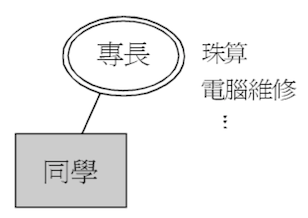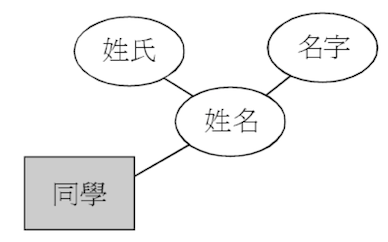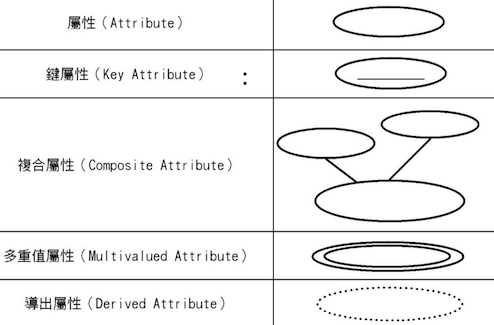[Database]ER Model 實體關聯模型
實體關聯模型(Entity-Relationship Model)
是Conceptual model(概念塑模)的一環,用來描述實體與實體之間關係的工具。
 |
|---|
| ER Model |
- 實體(Entity):是指用以描述真實世界的物件,在關聯式資料庫中為一個「資料表」
- 實體至少擁有一個不是鍵(主鍵)的屬性
- 一個實體可以含有多個「屬性」(Attribute)用以描述該實體,在關聯式資料庫中,以資料表的「欄位」來表示
- 例如:學生、員工、產品等等都是屬於實體
- 關係(Relationship):指用來表示「一個實體」與「另一個實體」關聯的方式
- 例如:一對一關係、一對多關係、多對多關係
實體(Entity)
定義
- a ”thing” in the real world with an independent existence
- 用來描述實際存在的事物(如:學生),也可以是邏輯抽象的概念(如:課程)
- 必須可以被識別,亦即能夠清楚分辨出兩個不同的實體(an independent existence)
- 以「名詞」的來命名,不可以是「形容詞」或「動詞」
分類
- 實體(entity)
- 弱實體(weak entity):必須依靠其他實體才能存在,若其依靠的實體消失,則該實體的存在也沒有意義了
- 例如:學生家長就是依附在學生實體的弱實體,若學生不存在,則家長也沒有存在的意義
圖示
 |
|---|
| Entity diagram |
屬性(Attribute)
定義
- 用來描述實體的性質(Property)(就是關聯式表格的行)
- 例如:學生的學號、名字、班級等等
分類
- 多值屬性 vs 單值屬性
- 多值屬性(Multivalued attributes):屬性值不只一個時,我們稱該屬性為多值屬性
- 例如:學生有多個專長,珠算、程式…
- 關係圖中以「雙橢圓形」來表示
- 單值屬性(Single-valued attribute):非多值屬性稱為單值屬性
- 多值屬性(Multivalued attributes):屬性值不只一個時,我們稱該屬性為多值屬性
 |
|---|
| 多值屬性 Multivalued attributes diagram |
- 複合屬性 vs 簡單屬性
- 複合屬性(Composite attributes):屬性由數個屬性所組成時,我們稱該屬性為複合屬性
- 例如:姓名由姓、名組成
- 關係圖如下
- 簡單屬性(Simple attribute):非複合屬性則稱為簡單屬性
- 複合屬性(Composite attributes):屬性由數個屬性所組成時,我們稱該屬性為複合屬性
 |
|---|
| 複合屬性 Composite attributes diagram |
- 衍生屬性(Derived Attribute)
- 它的值可以由其它屬性之值經由某種方式的計算或推論而獲得
- 例如:年齡和星座可由生日推算出來
鍵屬性(Key attribute)
定義
- 是指該屬性的值在某個環境下具有唯一性(primary key)
圖示
 |
|---|
| Attribute diagram |
關係(Relationship)
定義
- 是指用來表達兩個實體之間所隱含的關聯性
- 使用足以說明關聯性質的「動詞」或「動詞片語」命名
- 例如:『學生』與『系所』兩個實體型態間存在著一種關係─「就讀於」
分類
- 關聯強度 Strength
- 強關聯(strong relationship):a relationship where entity is existence-independent of other entities, and PK of Child doesn’t contain PK component of Parent Entity
- 弱關聯(weak (identifying) relationship):a relationship where Child entity is existence-dependent on parent, and PK of Child Entity contains PK component of Parent Entity,也就是說,此關聯是連結實體與弱實體
- Cardinality
- 1:1 一對一
- 1:N 一對多
- M:1 多對一
- M:N 多對多
- Participation constraints
- 全部參與(Total participation):every entity in the set is involved in the relationship
- 部分參與(Partial participation):not all entities in the set are involved in the relationship
圖示
 |
|---|
| Relationship diagram |
弱實體例子
為了區分和一般實體的關係, 我們會以雙菱形來表示實體與弱實體之間的關係, 而弱實體和關係之間以雙直線連接
 |
|---|
| Example |
以上圖為例,CHAPTER 必須依靠 BOOK 才能存在,所以 CHAPTER 是一個弱實體,兩者間用雙菱形(弱關聯)來連結。CHAPTER 用雙直線(Total participation)連接關係,因為 CHAPTER 是依靠 BOOK 而存在,表示每一個 CHAPTER 必定屬於某本 BOOK。而 CHAPTER 的 primary key 由 BOOK 的 primary key(BOOK ID) 與 CHAPTER ID 組成。
如果將上圖關係轉換成表格,CHAPTER 表格會有 {TITLE, CHAPTER ID, BOOK ID} 三個欄位,而 (CHAPTER ID, BOOK ID) 合併為 primary key。
Reference:
ER Model 實體關係圖
第4章 資料庫設計與實體關聯模型
利用實體-關係模型 (E-R Model) 規劃資料庫
Chen notation
資料庫基礎概念
